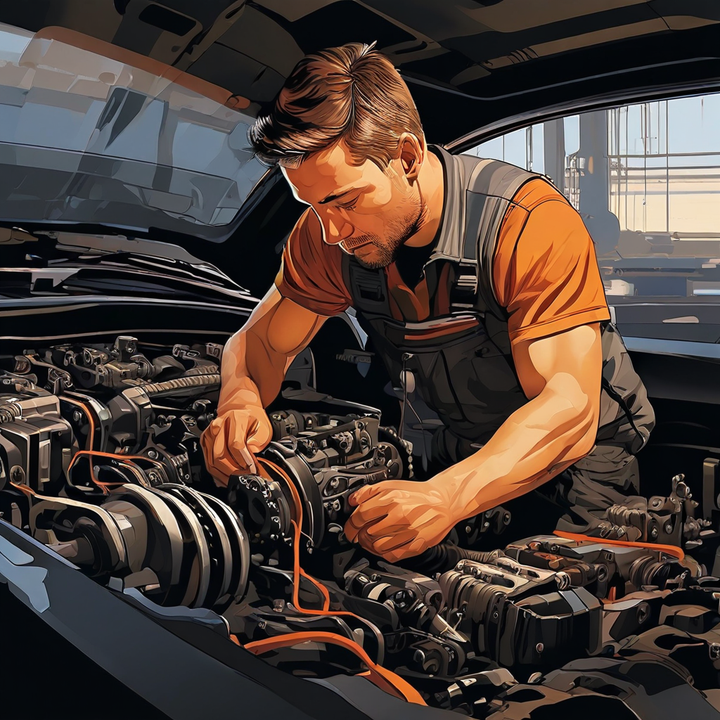


The diagnostic trouble code (DTC) P03EC refers to an issue with the camshaft profile actuator control circuit, specifically an open circuit condition in Bank 1. This code is part of the OBD-II system, which is used in modern vehicles to monitor and report various engine and vehicle system malfunctions. Understanding and troubleshooting this code is essential for maintaining engine performance and preventing further damage.
Before we dive into the heart of the matter, let's first shed light on the camshaft profile actuator itself. This ingenious component plays a pivotal role in optimizing your engine's performance and efficiency. Its primary function is to adjust the camshaft profile, which in turn controls the precise timing and duration of the intake and exhaust valves' opening and closing.
By meticulously regulating these valve events, the camshaft profile actuator ensures that your engine operates at its peak, delivering optimal power, fuel efficiency, and emissions control. It's like having a tiny maestro orchestrating the intricate dance of pistons, valves, and combustion within your engine's cylinders.
| Component | Function |
|---|---|
| Camshaft Profile Actuator | Adjusts the camshaft profile to control valve timing and duration |
| Intake Valves | Allow air/fuel mixture into the combustion chamber |
| Exhaust Valves | Expel exhaust gases from the combustion chamber |
| Pistons | Compress the air/fuel mixture and convert chemical energy into mechanical energy |
Now, let's dive into the heart of the matter – the P03EC code itself. This diagnostic trouble code is a warning signal from your vehicle's computer, indicating an issue with the camshaft profile actuator control circuit in the engine's bank 1 (typically the side with cylinder 1).
When this code is triggered, it could mean one of several potential problems, each with its own set of symptoms and consequences. From wiring gremlins to faulty components, the P03EC code can be a real headache if left unaddressed.
So, what could be causing this code to rear its ugly head? Well, let's take a look at some of the most common suspects:
Wiring Issues
Damaged or worn wiring harnesses
Loose connections or short circuits
Chafing or corrosion in the wiring
Faulty Camshaft Profile Actuator
Stuck or clogged actuator (solenoid or oil control valve)
Mechanical failure or wear of the actuator components
Camshaft Position Sensor Failure
Malfunctioning camshaft position sensor providing incorrect signals
Engine Control Module (ECM) Issues
Software glitches or calibration problems in the ECM
Damaged or faulty ECM requiring reprogramming or replacement
| Potential Cause | Description |
|---|---|
| Wiring Issues | Damaged wiring, loose connections, or short circuits |
| Faulty Actuator | Stuck, clogged, or mechanically compromised actuator |
| Sensor Failure | Malfunctioning camshaft position sensor |
| ECM Problems | Software glitches, calibration issues, or faulty ECM |
Now, let's roll up our sleeves and get our hands dirty with the diagnostic and repair process. As a seasoned mechanic, I've developed a systematic approach to tackling the P03EC code, ensuring a thorough and efficient resolution.
Visual Inspection
Conduct a thorough visual inspection of the wiring harness, connectors, and the camshaft profile actuator itself
Look for any signs of damage, corrosion, or loose connections
Resistance Testing
Use a digital multimeter to check the resistance of the camshaft profile actuator circuit
Test the camshaft position sensor for proper resistance and signal output
Compare the readings to the manufacturer's specifications
Scan Tool Diagnosis
Connect an OBD-II scan tool to the vehicle's diagnostic port
Check for any related trouble codes or live data parameters
Verify the ECM software version and update if necessary
Component Testing
Perform a functional test on the camshaft profile actuator by commanding it on and off using a scan tool
Monitor the camshaft position sensor output signal while cranking the engine
Once the root cause is identified, the repair process can begin. Here are the common repair procedures:
Wiring Repair
Replace any damaged wiring or connectors in the camshaft profile actuator control circuit
Ensure proper routing and secure connections to prevent future issues
Camshaft Profile Actuator Replacement
Follow the manufacturer's instructions to remove and replace the faulty camshaft profile actuator
Ensure proper installation and lubrication of the new actuator
Camshaft Position Sensor Replacement
Replace the camshaft position sensor if found faulty or not meeting specifications
ECM Reprogramming or Replacement
Update the ECM software or replace the ECM if diagnosed as the root cause
| Repair Procedure | Description |
|---|---|
| Wiring Repair | Replace damaged wiring and secure connections |
| Actuator Replacement | Remove and replace the faulty camshaft profile actuator |
| Sensor Replacement | Replace the malfunctioning camshaft position sensor |
| ECM Reprogramming/Replacement | Update or replace the Engine Control Module (ECM) |
As with any automotive issue, prevention is always better than cure. To minimize the chances of encountering the P03EC code, I recommend following these maintenance best practices:
Regular Oil Changes
Follow the manufacturer's recommended oil change intervals
Use the correct oil viscosity and quality as specified by the manufacturer
Prevent sludge buildup and contamination, which can lead to camshaft component issues
Wiring Inspection
Regularly inspect the wiring harnesses and connectors for any signs of damage or wear
Ensure proper routing and protection from potential chafing or heat sources
Proper Driving Habits
Avoid excessive idling or high-load conditions that can accelerate wear on the camshaft components
Follow the recommended break-in procedures for new vehicles or after major repairs
| Maintenance Practice | Benefit |
|---|---|
| Regular Oil Changes | Prevents sludge buildup and contamination |
| Wiring Inspection | Catches potential wiring issues early |
| Proper Driving Habits | Extends the lifespan of camshaft components |
Now, let's address the elephant in the room – the cost of repairs. The expenses associated with resolving the P03EC code can vary widely depending on the specific cause and the labor rates in your area. Here's a general estimate to give you an idea:
| Repair | Estimated Cost Range |
|---|---|
| Wiring Repair | $100 - $300 (parts and labor) |
| Camshaft Profile Actuator Replacement | $300 - $800 (parts and labor) |
| Camshaft Position Sensor Replacement | $150 - $400 (parts and labor) |
| ECM Reprogramming or Replacement | $200 - $1,000 (parts and labor) |
Keep in mind that these are rough estimates, and the actual cost may vary based on your vehicle's make, model, and condition. It's always best to consult with a professional mechanic or dealership for an accurate cost estimate specific to your situation.
Troubleshooting the P03EC code can be a challenging endeavor, but with the right knowledge and approach, it's a puzzle that can be solved. As a mechanic, I've learned that patience, attention to detail, and a systematic diagnostic process are key to unraveling even the most perplexing automotive issues.
Remember, your vehicle's camshaft profile actuator plays a crucial role in ensuring optimal performance and efficiency. Ignoring the P03EC code can lead to further complications and potentially costly repairs down the line. By addressing the issue promptly and following proper maintenance practices, you can keep your engine running smoothly and extend its lifespan.
So, the next time you encounter the P03EC code, don't panic. Instead, embrace the challenge, roll up your sleeves, and let your mechanical expertise shine. With the right tools and knowledge, you'll be able to tame this code and keep your vehicle purring like a well-oiled machine.
Happy wrenching, my fellow automotive enthusiasts!
The camshaft profile actuator adjusts the camshaft profile to control valve timing and duration. This optimizes engine performance, fuel efficiency, and emissions control.
The actuator uses hydraulic pressure or electro-mechanical mechanisms to change the position of the camshaft, altering the timing of when the intake and exhaust valves open and close.
Common symptoms include rough idling, engine misfires, lack of power, decreased fuel efficiency, and illumination of the check engine light.
Yes, if left unaddressed, a malfunctioning camshaft profile actuator can potentially cause damage to other components like exhaust valves or pistons.
Yes, some reputable aftermarket manufacturers offer camshaft profile actuators that can be more reliable and durable than OEM parts, but proper research is recommended.
Inspection and replacement intervals vary, but generally range from 60,000 to 100,000 miles, or as recommended by the manufacturer's maintenance schedule.
Yes, driving with a malfunctioning camshaft profile actuator can lead to decreased engine performance, reduced fuel efficiency, and potentially severe engine damage if left unaddressed.
The "A" actuator typically controls the intake camshaft, while the "B" actuator controls the exhaust camshaft in a dual overhead cam (DOHC) engine or V-engine configuration.
Regular oil changes, proper oil viscosity, wiring inspections, and avoiding excessive idling or high-load conditions can help prevent issues with the camshaft profile actuator.
Yes, a malfunctioning camshaft position sensor can provide incorrect signals, potentially triggering a diagnostic trouble code related to the camshaft profile actuator control circuit.

Miguel started tinkering with car radios as a teenager, fascinated by the intricate dance of wires and circuits. This passion led him to pursue a career as an automotive electrician. For the past 10 years, Miguel has tackled everything from flickering headlights to mysterious electrical gremlins. He thrives on troubleshooting electrical problems and enjoys sharing his knowledge to empower car owners to understand their vehicles better.



